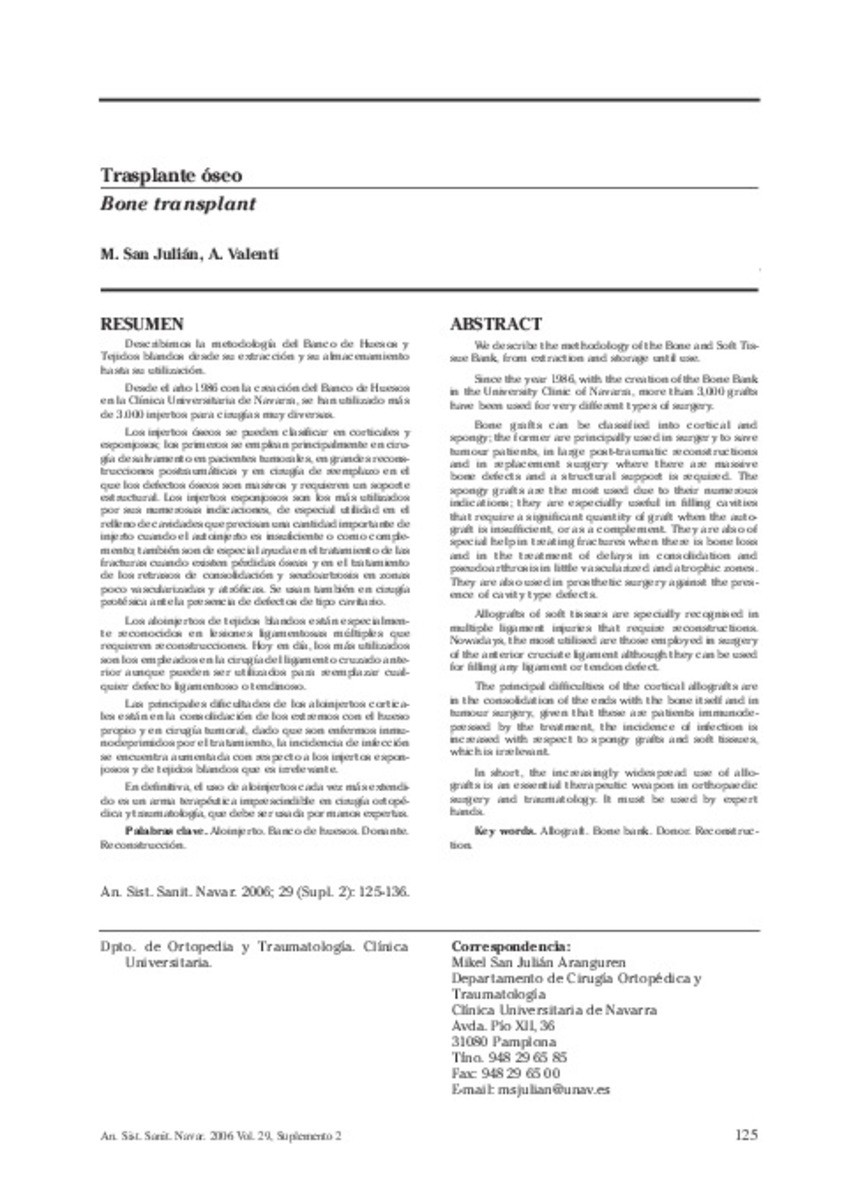Full metadata record
| DC Field | Value | Language |
|---|---|---|
| dc.creator | San-Julian, M. (Mikel) | - |
| dc.creator | Valenti, A. (Andrés) | - |
| dc.date.accessioned | 2012-06-21T18:11:23Z | - |
| dc.date.available | 2012-06-21T18:11:23Z | - |
| dc.date.issued | 2006 | - |
| dc.identifier.citation | San Julian M, Valenti A. Trasplante óseo. An Sist Sanit Navar 2006;29 Suppl 2:125-136. | es_ES |
| dc.identifier.issn | 1137-6627 | - |
| dc.identifier.uri | https://hdl.handle.net/10171/22674 | - |
| dc.description.abstract | We describe the methodology of the Bone and Soft Tissue Bank, from extraction and storage until use. Since the year 1986, with the creation of the Bone Bank in the University Clinic of Navarra, more than 3,000 grafts have been used for very different types of surgery. Bone grafts can be classified into cortical and spongy; the former are principally used in surgery to save tumour patients, in large post-traumatic reconstructions and in replacement surgery where there are massive bone defects and a structural support is required. The spongy grafts are the most used due to their numerous indications; they are especially useful in filling cavities that require a significant quantity of graft when the autograft is insufficient, or as a complement. They are also of special help in treating fractures when there is bone loss and in the treatment of delays in consolidation and pseudoarthrosis in little vascularized and atrophic zones. They are also used in prosthetic surgery against the presence of cavity type defects. Allografts of soft tissues are specially recognised in multiple ligament injuries that require reconstructions. Nowadays, the most utilised are those employed in surgery of the anterior cruciate ligament although they can be used for filling any ligament or tendon defect. The principal difficulties of the cortical allografts are in the consolidation of the ends with the bone itself and in tumour surgery, given that these are patients immunodepressed by the treatment, the incidence of infection is increased with respect to spongy grafts and soft tissues, which is irrelevant. In short, the increasingly widespread use of allografts is an essential therapeutic weapon in orthopaedic surgery and traumatology. It must be used by expert hands. | es_ES |
| dc.language.iso | spa | es_ES |
| dc.publisher | Gobierno de Navarra. Departamento de Salud | es_ES |
| dc.rights | info:eu-repo/semantics/openAccess | es_ES |
| dc.subject | Allograft | es_ES |
| dc.subject | Bone bank | es_ES |
| dc.subject | Donor | es_ES |
| dc.title | Trasplante óseo | es_ES |
| dc.title.alternative | Bone transplant | es_ES |
| dc.type | info:eu-repo/semantics/article | es_ES |
| dc.relation.publisherversion | http://www.cfnavarra.es/salud/anales/textos/vol29/sup2/suple12.html | es_ES |
| dc.type.driver | info:eu-repo/semantics/article | es_ES |
Files in This Item:
Statistics and impact
Items in Dadun are protected by copyright, with all rights reserved, unless otherwise indicated.






